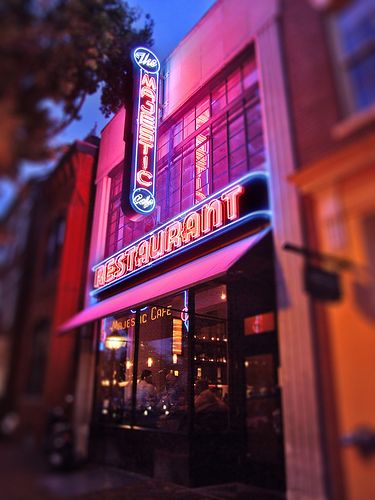
photo by Focht.
On a beautiful, warm Saturday night recently, Len and I headed over to Old Town Alexandria for dinner at the Majestic Café. You may remember my mentioning that Mrs. Obama hosted a birthday dinner there for her mother, Marian Robinson, this past summer.
Of course we had to check it out. (This is my favorite kind of "blog homework.")
The Majestic, with its art deco facade, dates back to 1932, and is a Virginia state landmark. It boasts "pure and simple food in rustic American style" -- wholesome, fresh, locally sourced ingredients -- farm-to-table goodness that seems to be the credo these days of foodies in the know.

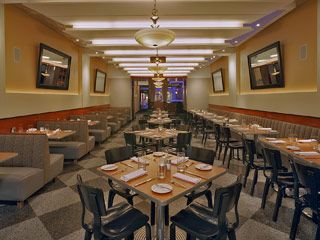
You enter through the bar to access the long dining room.
The interior was unremarkable, not "historic" as I had envisioned, but the food and service more than made up for it. Our servers were exceptionally friendly and attentive; Len and I noted they all looked uncommonly intelligent (both men and women were tall and lean with black rimmed glasses). We could have easily pictured them at a marathon reading of Proust. Okay, Len swore one female server resembled Olive Oyl, but that's just him. Do you like to cast people you see in restaurants for future stories or films? ☺
Everything except the butter is made in-house, including breads, chips, pickles, and pasta, and they like to remind you that even the water is filtered in-house. They love to refill your water glass the minute you take a sip, and every time you finish a course, they carefully wipe your table polish it to a high gloss. Yes, this may well have been the cleanest, shiniest table in the history of the world.
Being thus coddled by the wait staff (and the lovely hostess was also very pleasant), we drooled over the menu, which offered lots of comfort food: meat loaf with mashed potatoes and green beans, creamy tomato soup, crabcakes, grilled chicken, hanger steaks, calves liver (yuck).
Len started with fried green tomatoes (goat cheese, caramelized onions, fresh beets):
followed by the Chesapeake Bay seafood stew:
I had a mixed greens salad (pomegranates, vinaigrette dressing, caramelized onion, chopped nuts), which was perfection:
followed by roast pork (brussels sprouts, apples, onions, bacon):
This was the best roast pork I've ever eaten in a restaurant anywhere -- fork tender and moist, with the perfect sauce. Seriously, we're talking foodgasm. Couldn't stop saying, "mmmmmm, mmmmmmm, mmmmmm."
&nbs
Viewing: Blog Posts Tagged with: presidential food, Most Recent at Top [Help]
Results 1 - 6 of 6
Blog: jama rattigan's alphabet soup (Login to Add to MyJacketFlap)
JacketFlap tags: presidential food, fall for restaurants 2009, Add a tag
Blog: jama rattigan's alphabet soup (Login to Add to MyJacketFlap)
JacketFlap tags: abraham lincoln, presidential food, mary todd lincoln's white cake, Add a tag
"My dream is of a place and a time where America will be seen as the last best hope of earth." ~ Abraham Lincoln
Lincoln with his son, Tad, as photographed by Matthew B. Brady (February, 1864)
Our greatest President is 200 years young today.
Wherever he is, he's probably thrilled about who's occupying his former digs at 1600 Pennsylvania Avenue. Lincoln would be especially pleased to see Malia and Sasha living there, since he was the first President to bring his own small children to live in the White House.
Abe was an indulgent parent, who loved to wrestle with his sons. They provided much needed relief from the tensions of the war, sometimes throwing strawberries around at Cabinet meetings, climbing on furniture, and scattering papers.
Strawberries? Hmmm. What else did our 16th President like to eat? He was our tallest at 6'4", so it seems he would have had a large appetite, but most historians disagree.
His usual breakfast was hot coffee and an egg, sometimes with toast. For lunch, perhaps a biscuit, a glass of milk and some fruit. John Hay, one of Lincoln's private secretaries, said, "he ate less than anyone I know," and Lincoln's law partner, Billy Herndon, said, "Abe can sit and think longer without food than any man I ever met."
Mary Todd Lincoln was often exasperated with Lincoln's eating habits. She loved to host levees and set a fine table, but Lincoln was just as happy with fruit salad, perhaps with cheese and crackers, for dinner. It's not that he didn't enjoy food; he was just very often too preoccupied with his duties to remember to eat. Unlike Thomas Jefferson, who was a true gourmand, fascinated by every aspect of food production and preparation, Abe ate to fuel the furnace, and preferred simple fare.
MENU FOR LINCOLN'S INAUGURAL LUNCHEON (March 4, 1861)*
Mock Turtle Soup
Corned Beef and Cabbage
Parsley Potatoes
Blackberry Pie
Coffee
(he planned the menu himself)
Some of his favorites? Apples, eaten out of hand or baked in pies or cakes. Chicken fricasse and oyster stew. He also retained his appetite for the frontier foods he was raised on -- corn dodgers, wild game, eggs, and bacon. Cornbread with honey was a special treat, and he loved sweets in general, especially the gingerbread men cookies from childhood, and the pecan pie procured at a Washington, D.C., bakery.
Mary was quite eccentric, and a certified shop-a-holic.
But there was one special dessert that figured even more prominently in Abe's personal life, and that was Mary Todd Lincoln's Vanilla Almond Cake. As the story goes, she baked this family favorite for him while they were courting, and he pronounced it, "the best in Kentucky." That sealed the deal, and they were marrried a few years later. It is believed the cake remained a staple in the Todd-Lincoln home in Springfield (where Mary did her own cooking because they couldn't afford help), and later when they moved into the White House.
Some cake! There are several modernized versions of Mary's recipe floating around, most requiring lots of egg whites and a cooked syrup frosting. I decided to try the recipe found in Lincoln's Table, by Donna D. McCready (Lincoln's Presentations, 2008), which calls for powdered sugar instead of frosting. It's not overly sweet at all -- more like a nice coffee cake. It's really the perfect way to celebrate Abe's Bicentennial, Presidents' Day and Valentine's Day. But watch out -- someone might fall in love with you!
MARY TODD LINCOLN'S WHITE CAKE
(makes about 12 slices)
1 cup blanched almonds
2 cups granulated sugar
3 cups all purpose flour
3 tsp baking powder
1 cup milk
6 eggs, separated (best when eggs are cold)
1 tsp vanilla extract
Confectioners' sugar
Using a food processor or spice grinder, pulverize almonds until they resemble coarse flour.
Preheat oven to 350 degrees. Grease and flour a Bundt cake pan.
With an electric beater or stand mixer, cream butter and sugar until light yellow in color and fluffy.
Sift flour and baking powder three times. Fold flour mix into creamed butter and sugar, alternating with milk, until well blended. Stir in almonds and beat well.
In a separate bowl, beat egg whites until they have stiff, firm peaks. Beaters must be washed and dried thoroughly before whipping egg whites or they will not stiffen properly. Fold egg whites gently into butter with rubber spatula. Add vanilla extract.
Pour batter into prepared pan and bake for one hour, or until a skewer inserted comes out clean.
Cool for at least 20 minutes before inverting, then allow to cool completely before serving. Sift confectioners' sugar on top.
Check this out: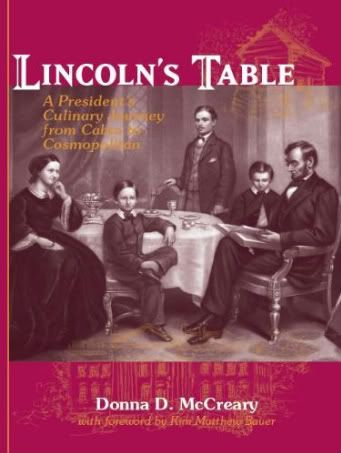
Contains 130 recipes chronicling Lincoln's life from boyhood to Presidency.
What foods shaped our greatest President?
More more more:
If you'd like to try the Vanilla Almond Cake recipe with frosting, click here.
*President Obama's Inaugural Luncheon Menu was created to honor Lincoln and his culinary preferences. The recipes for all the dishes served on January 20, 2009, can be found here.
Elaine at Wild Rose Reader has posted an awesome list of books and other resources related to the Lincoln Bicentennial here.
An avalanche of new children's books about Lincoln were published in 2008 and more are still to come in 2009. See some of them here.
Click here to see my Poetry Friday post about Lincoln's favorite poem.
If you're hungry for more mouth watering, fascinating tidbits about Presidents and their favorite foods, click here.
One Final Tasty Tidbit: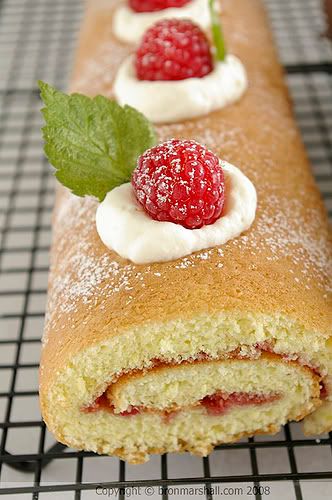
photo by Bron Marshall
*One of our earliest recipes for jelly roll, or jelly cake (sometimes called Lincoln Log), came from Laura Keene, an actress performing in Our American Cousin at Ford's Theatre the night Lincoln was shot. It was published in The American House Wife Cook Book, by T.S. Shute (1878).

Blog: jama rattigan's alphabet soup (Login to Add to MyJacketFlap)
JacketFlap tags: fall frolic, presidential food, gadsby's tavern, Add a tag
~ This is the seventh in a series of posts about Presidential Food
Important things can happen in a tavern.
Random, fun, history-making, world-changing important things.
Like resting from a long day of travel and savoring a good meal with friends, dancing the night away in the ballroom, or attending a musical or theatrical performance. While you're there, why not meet with other like-minded people to plan a revolution?
Our founding fathers certainly found Gadsby's Tavern in Alexandria, Virginia, to be the place. During the 18th and early 19th centuries, it was the political, business and social center of the city. Its reputation as an elegantly appointed establishment attracted many of the important political figures of the day.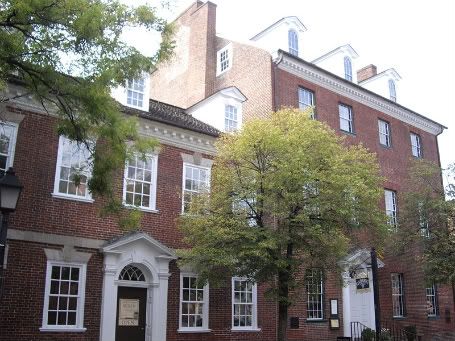
Gadsby's is actually two buildings; 1785 tavern on the left, 1792 City Hotel on the right, which houses the restaurant, and was considered a skyscraper back in the day.
Washington headquartered here during the revolution, and delivered his farewell address to his soldiers on the front steps at war's end. Jefferson's inaugural dinner and ball took place here. In fact, our first five Presidents all spent time here, chatting about America over their rum punch and Madeira.
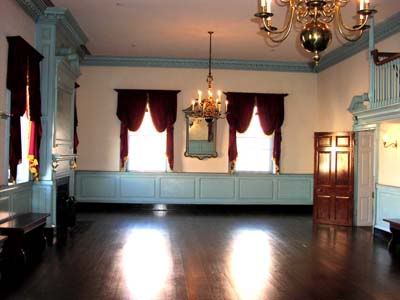
Third floor ballroom; 5 Presidents partied here.

Photos © Office of Historic Alexandria
No public building in America is more intimately associated with the struggle for independence and establishment of national sovereignty.
Recently, Len and I were lucky enough to be invited to dine at Gadsby's. It was our third time there, and always a treat. The tavern has been beautifully restored and features Colonial fare served by knowledgeable "in character" servers.
Colonial hottie sets our table.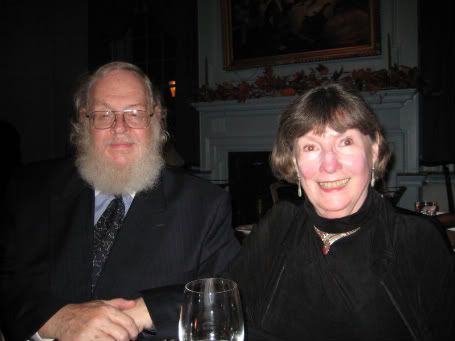
Frank, a professor from Ohio, and Liz, our hostess.
I had the seafood plate (rockfish, shrimp and scallops).
Len had the gentleman's pie.
Mr. John Hall, an urbane raconteur and minstrel, delighted everyone with his rollicking and bawdy wit. He wandered from table to table, greeting visitors with tidbits about life in the 18th century. I asked him if Mr. Jefferson had been by lately, and he said he had not seen the President for some time, as he had been in seclusion over matters of State.
Mr. Hall regaled us with "Greensleeves."
Mr. Hall couldn't take me up on my engagement offer because of his "wife of 26 year."
A quick glance around the room proved interesting, too -- I saw Sara Zarr and Sameera Righton look-alikes, a man with an ill-fitting wig, and a woman who had stolen my necklace. We reluctantly called it a night, disappointed at not seeing Lafayette or John Paul Jones.
I think I should collect Colonial taverns; it's so much fun imagining people of yore gathering, noshing, celebrating, gossiping, and debating, while cooking up a recipe for a new nation. What those walls must have heard! Merriment and a mission.
See the other Presidential Food posts here.
*Photo of Gadsby's exterior by Dmadeo, Creative Commons Attribution-ShareAlike 3.0 Unported License.
Blog: jama rattigan's alphabet soup (Login to Add to MyJacketFlap)
JacketFlap tags: barack obama, fall frolic, presidential food, Add a tag
~ This is the sixth in a series of posts about Presidential Food
"Tell me what you eat and I will tell you what you are." ~ Jean Anthelme Brillat-Savarin (lawyer, author, epicure)
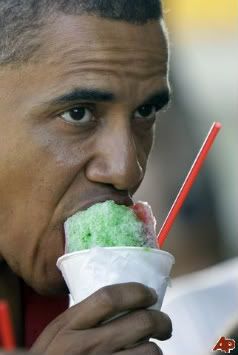
Shave ice of many flavors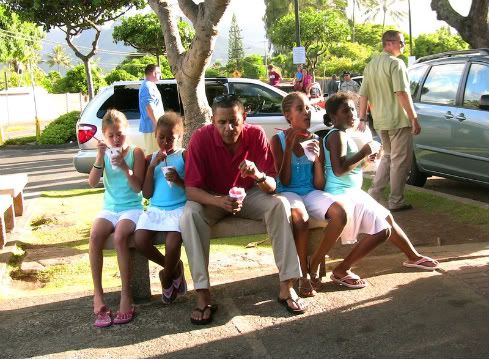
Flanked by the ladies in Hawai'i this past summer.
Right about now, all five White House chefs are probably wondering what's going to be on the menu for the next four years.
Will they have to brush up on their Chicago pizza skills? Import bags of poi from Hawai'i? Or will they be asked to serve their culinary creations on green plates?

Barack's Pizza Policy: vegetarian
Regular readers of this blog (all three of you) know that I'm a strong believer in the old adage, "you are what you eat." When it comes to food in the White House, each First Family has brought something distinct to the table -- not only with regard to what is served, but how it's served. There is nothing more revealing of personality than one's style of entertaining.
It'll be interesting to see whether Michelle Obama will follow Nancy Reagan's lead, attending to every minute detail of preparation and presentation, or be more like Pat Nixon, who was happy to allow the chefs to surprise her. Whatever the case, her culinary decisions will definitely impact the outcome of official gatherings.
James Beard once said that "food is our common ground, a universal experience." Since establishing common ground is such a crucial part of the new President's agenda, strict attention should be paid to serving food that fosters diplomacy. (Dip everything in chocolate, I say!)
I predict the Obama administration will be known for innovative, culturally diverse cuisine with an emphasis on fresh, naturally produced, organic ingredients. Arugula will replace iceberg, tropical fruit will grace the breakfast table, and state dinners will feature dishes influenced by Barack's African, Hawaiian, and Indonesian roots. All to say, not too much emphasis on the flash and glam, but a nod to eating as close to the source as possible.

Tasting cheese in the Italian Market section, Philadelphia (April 2008)

Ah, Mexican!
Private family dinners, with two young girls in the house, will get real with typical American family fare -- pizza, chicken wings, pasta, cheese toast, and Barack's famous chili. Yes, the man can cook! As a bachelor, he had a roommate who taught him how to cook Indian food, and he credits having lived in Hawai'i for his knowledge of Chinese cuisine. (See his interview on 60 Minutes here, where he makes tuna salad.) Perhaps if she can find a spare minute, Michelle will whip up a batch of seafood gumbo, the first dish she ever cooked for Barack.
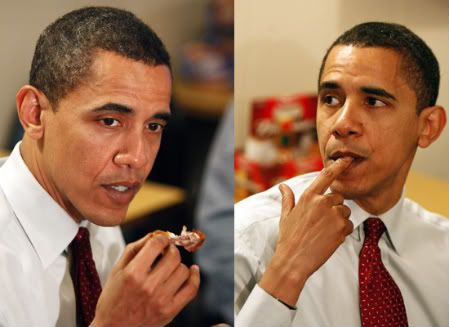
A chicken wing and a tasty finger
After being in Washington for awhile, the Obamas might miss some of their favorite hometown restaurants -- Topolobampo (nouveau Mexican), R.J. Grunts (downhome ribs, burgers, salad bar, Tex-Mex), and Italian Fiesta Pizzeria (a non-descript, mini-mall joint near their South Side home).
Michelle's favorite upscale spot is Sepia, whose seasonal menus are "rooted in tradition, melding rustic sensibility with contemporary flair." It sounds divine, as it was built from an 1890's print shop, and supports "local artisan growers using sustainable practices." No doubt her refined palate will find its way into more formal White House events, but I predict the meals will be served in a relaxed setting conducive to candid conversation.
I'm still euphoric about the outcome of the election, and thought the perfect way to celebrate would be to try an Obama family recipe. Here is a yummy pasta dish, sure to please kids as well as adults. It's perfect for busy families looking for a healthy, nutritious meal without too much fuss. I used regular linguini here, but of course you can go a healthier route -- whole wheat or gluten-free (I love Pasta Joy's brown rice pasta). Make some soon, in honor of Michelle, Malia, Sasha, and Pumski*!
OBAMA FAMILY'S LINGUINI WITH SHRIMP
1-1/2 lbs. fresh shrimp (shell on)
several garlic cloves
sun-dried tomatoes (sliced in olive oil)
chicken broth
1 box linguini
fresh basil, julienned
1 T olive oil
Clean, de-vein shrimp. Remove shells and soak them in hot chicken broth.
Thinly slice garlic (the more garlic, the better flavor of the dish).
Cook pasta and set aside (do not overcook).
In large saute pan, heat olive oil on high heat and saute garlic cloves until they begin to brown slightly.
Add fresh shrimp and cook until just beginning to turn pink. Add salt and pepper to flavor shrimp.
Add sun-dried tomatoes and continue to cook for another minute.
Add pasta. Mix pasta into garlic, shrimp and sun-dried tomato mixture until it is coated entirely with mixture. Add salt and pepper to taste.
Slowly add a bit of the shrimp shell and chicken broth liquid to remove reserves from bottom of pan.
Remove pan from heat and let sit for a few moments.
Add basil over top to garnish.
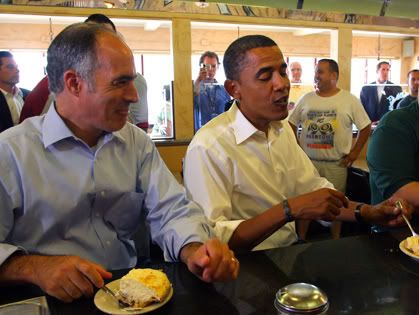
There's always room for pie.
For some beautiful photos from the Honolulu Star Bulletin archives of the Obamas in Hawai'i, click here.
Tasty Infobites about Barack:
Favorite music: John Coltrane, Miles Davis, Stevie Wonder, Earth, Wind and Fire, Bach, Elton John, Bob Dylan.
Favorite books: Song of Solomon (Toni Morrison), Moby Dick, Shakespeare's tragedies, Self Reliance (Emerson), Parting the Waters, Gilead (Robinson), Lincoln's collected writings, Bible
Favorite movies: Godfather I and II, One Flew Over the Cuckoo's Nest, Lawrence of Arabia, Casablanca
Favorite quote: "The Arc of the Moral universe is long, but it bends towards justice" (Martin Luther King, Jr.).
*On the Paula Deen Show, Michelle revealed that her pet nickname for Barack is "Pumski." Wonder if pumpkin dishes will show up on the White House menu?
**If you insist on dessert, try Michelle's Apple Cobbler!
See all the Presidential Food posts here.
"You can't really understand Barack until you understand Hawai'i."
~ Michelle Obama
Blog: jama rattigan's alphabet soup (Login to Add to MyJacketFlap)
JacketFlap tags: thomas jefferson, fall frolic, presidential food, Add a tag
~ This is the fifth in a series of posts about Presidential Food.
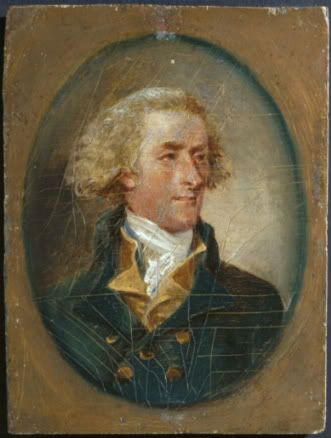
Jefferson Miniature by John Trumbull
No President outshines Thomas Jefferson when it comes to
food and wine -- the appreciation, consumption, and cultivation of it were for him lifelong passions.
West Front and Garden, Monticello, by Jane Braddick Peticolas
An enlightened epicure, his table included Southern staples such as Virginia ham, black-eyed peas, corn, venison, sweet potatoes, and turnip greens, alongside the many French dishes he first tasted in Paris while serving as foreign minister for four years. He loved entertaining, and impressed his guests with "sinful feasts," featuring as many as a dozen desserts, including blanc mange, meringues, and macaroons.
Breakfast with the Madisons by G.B.McIntosh
He was a connoisseur of fine wines, and considered it, along with olive oil, to be a necessity of life. Four to six wines (imported by the barrel from France, Italy, Spain and Portugal) were served at his dinners. He was attentive and particular when it came to food preparation, and insisted on serving seasonal produce at its peak. Of course he grew everything on his estate, practicing a very scientific approach to horticulture.
In his Garden Notebook, Jefferson meticulously recorded information about everything he planted -- facts about all the seeds he imported from Europe or acquired from neighbors, to include dates of planting, first leaves, first harvest, first appearance at table, etc.

Monticello grapes
You probably know about his 1000-foot long vegetable garden at Monticello, where he cultivated over 300 varieties of about 70 species of vegetables, including at least 30 varieties of peas (his favorite). His garden was his laboratory: "I am curious to select one or two of the best species or variety of every garden vegetable, and to reject all others from the garden to avoid the dangers of mixing or degeneracy."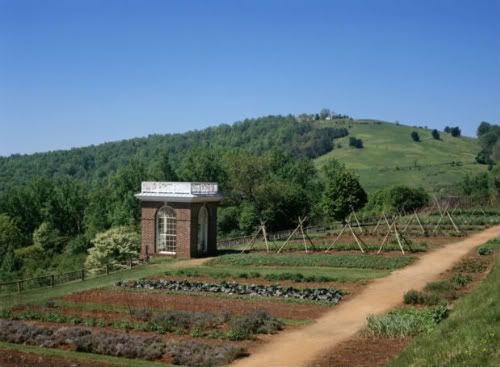
Monticello vegetable garden and pavillion
Though he's not considered a vegetarian by today's standards, vegetables did make up much of his diet. Salads were especially important to him, as was the cultivation of sesame and olives (to make dressings). Besides English peas, he loved asparagus, artichokes, eggplant, tomatoes, broccoli and cauliflower.
He also had an eight-acre "Fruitery," which included a South Orchard of 400 trees (peach, apple, cherry), two vineyards,"berry squares" of currants, gooseberries, and raspberries, and a nursery where he propagated fruit trees and special garden plants. His North Orchard consisted of only apple and peach trees, and was more a "farm orchard," since the fruit was harvested for cider, brandy, or livestock feed. Together, the fruitery and farm orchard represented "the best of the European heritage combined with a distinctive New World vitality and personality."
Because Jefferson was a widower when he was elected President, his daughter, Martha Jefferson Randolph, along with Dolley Madison, often served as hostesses for gatherings at the President's House (White House). Martha included many of her father's favorite recipes in her 1824 cookbook, The Virginia Housewife.
What I found especially interesting was Jefferson's preference for small, private dinners, served daily at 4 p.m. He favored the more relaxed nature of these over the aristocratic levees of the Federalists. His guests were carefully chosen to facilitate social harmony -- he never mixed political parties, or invited Cabinet members along with Congressmen. They were seated at round or oval tables to promote conviviality and a feeling of equality, and were encouraged to speak freely on all subjects. The use of a dumb waiter insured privacy.

Monticello Dining Room
Jefferson was most famous for the policy of "pell-mell," which allowed for diplomats or foreign ministers to sit next to family members or strangers, without precedence. He said, "When brought together in society, all are perfectly equal, whether foreign or domestic, titled or untitled, in or out of office."
One of his guests remarked: "Never before had such dinners been given in the President's house, nor such a variety of the finest and most costly wines. In his entertainments republican simplicity was united with epicurean delicacy; while the absence of splendor, ornament and profusion was more than compensated by the neatness, order, and elegant sufficiency that prevaded the whole establishment . . . "
Though none of Jefferson's dinner menus has survived, there are private accounts such as this one, by the Reverend Cutler, who said the menu included:
"rice soup, round of beef, turkey, mutton, ham, loin of veal, cutlet of mutton or veal, fried eggs, fried beef..." and "a pie called macaroni." For dessert there was "Ice-cream very good, crust wholly dried, crumbled into thin flakes; a dish somewhat like a pudding - inside white as milk or curd, very porous and light, covered with creamsauce - very fine." In addition to all of this, Jefferson served "other jimcracks, a variety of fruit, plenty of wines, and good."
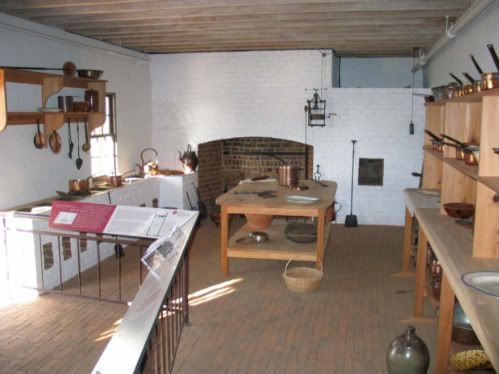
Monticello kitchen
Speaking of ice cream, Jefferson has been credited with recording the first American recipe for it (which he brought back from France), although it was Washington who supposedly owned the first ice cream freezer. Jefferson also introduced macaroni and vanilla to the U.S., and purchased a waffle maker from Holland. Wherever he traveled in Europe, he tasted the local cuisine, recorded recipes, and once back in the U.S., imported the delicacies he especially favored.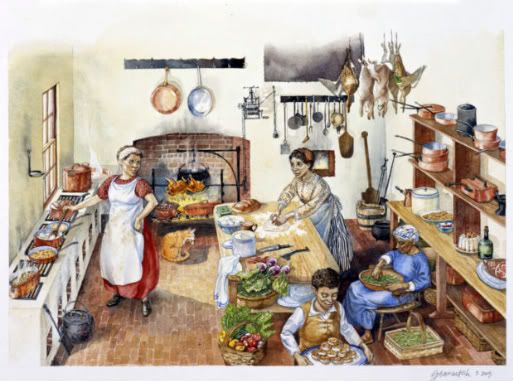
Working in the Monticello Kitchen by G.B. McIntosh
The Jeffersonian tradition of fine cuisine was inherited by all six of his granddaughters, who hand-copied recipes -- whether from old family cookbooks, or the chef, the steward, or neighbors -- into notebooks. These were considered to be one of their greatest treasures as they set up their own households as new brides. 
Monticello Tea Room
Some of these recipes, along with recipes Jefferson brought back from Paris, are included in Thomas Jefferson's Cook Book, by Marie Kimball, considered by Craig Claiborne to be "the most comprehensive work yet compiled on Jefferson's gastronomic adventures." It's a fascinating read, with an excellent essay,"Thomas Jefferson . . . Gourmet," by Helen D. Bullock.
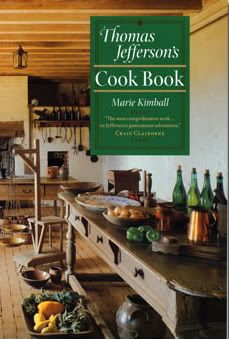
Only ten recipes survived in Jefferson's own handwriting; I was especially happy to see this one:
Observations on Soups
Always observe to lay your meat in the bottom of the pan with a lump of butter. Cut the herbs and vegetables very fine and lay over the meat. Cover it close and set over a slow fire. This will draw the virtue out of the herbs and roots and give the soup a different flavour from what it would have from putting the water in at first. When the gravy produced from the meat is almost dried up, fill your pan up with water. When your soup is done, take it up and when cool enough, skim off the grease quite clean. Put it on again to heat and then dish it up. When you make white soups, never put in the cream until you take it off the fire. Soup is better the second day in cool weather.
In case you'd like to breakfast with Mr. Jefferson, read about and try this recipe for English muffins. Or, if you prefer a sinful dessert, make some macaroons!
MORE:
Monticello.org is a veritable gold mine of information about Thomas Jefferson, comprehensive and beautifully presented. The resources for kids and teachers are invaluable, especially the Jefferson Encyclopedia and the Monticello classroom.
Also check out:
Dining at Monticello: In Good Taste and Abundance, edited by Damon Lee Fowler (University of North Carolina Press, 2005). A gorgeous book with background essays by experts about how Monticello cooks were trained, what part African Americans played in Monticello's food culture, and how Jefferson mixed diplomacy with food. Recipes too!
My favorite picture book biographies of Jefferson:
Thomas Jefferson, by Cheryl Harness (National Geographic, 2007). Engaging text and wonderfully detailed illustrations.
Thomas Jefferson: A Picture Book Biography, by James Cross Giblin (Scholastic, 1994). A stately text illuminated with exquisite oil paintings.
And a thoroughly delightful, funny story kids will love:
A Big Cheese for the White House: The True Tale of a Tremendous Cheddar, by Candace Fleming, pictures by S.D. Schindler (DK Ink, 1999). The people of Cheshire attempt to make the country's biggest cheese when they hear Jefferson was serving Norton cheese at the White House. The result? A wheel that stood four feet high and weighed 1,235 pounds! Needless to say, Jefferson served Cheshire cheese for a long time after that. Thomas Tidbit: Jefferson can also be considered to be the bravest gourmet President, since he once smuggled Italian rice in his coat pockets. This was a crime punishable by death, but he liked the rice so much he took his chances!
Thomas Tidbit: Jefferson can also be considered to be the bravest gourmet President, since he once smuggled Italian rice in his coat pockets. This was a crime punishable by death, but he liked the rice so much he took his chances!
*All photos and quotes from Monticello.org website.
Blog: jama rattigan's alphabet soup (Login to Add to MyJacketFlap)
JacketFlap tags: fall frolic, presidential food, reagans, Add a tag
So where did those jelly beans come from? He started eating them while trying to quit smoking. They quickly became known as the "First Candy," and 2.3 million of them were consumed by guests at his first inauguration.
~ This is the third in a series of posts about Presidential Food
~ "You can tell a lot about a fellow's character by his way of eating jelly beans." ~ Ronald Reagan
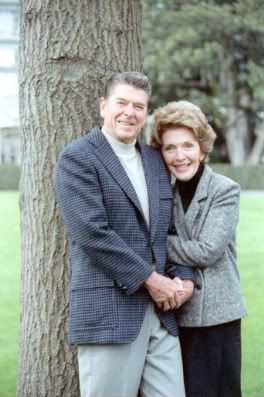
Weren't they a beautiful couple?
The Reagans brought elegance, glamour and a degree of formality to the White House. Over the course of 8 years, they supposedly entertained about 75,500 guests per year, including seven kings, three queens, thirteen princes, and seventy-seven prime ministers. Not to mention all those movie stars.
Private dinner for Prince Charles (1981), President's Dining Room
With the expertise of White House Executive Chef Henry Haller and Pastry Chef Roland Mesnier, Nancy orchestrated many, many finely tuned, exquisite private and official State Dinners, luncheons and teas. 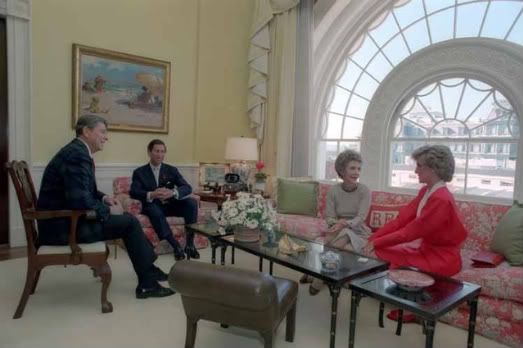
Tea with Charles and Diana (1985)
The President had a sweet tooth, always taking a large serving of dessert, and then having seconds. He loved honey-baked apples and chocolate. Nancy took great pride in their "dessert dinners," constantly challenging the Chefs to create new dishes that were light (fruit oriented), sophisticated, and pleasing to the eye.
But sweets aside, Nancy was very diligent about ensuring that the Great Communicator had a balanced, nutritious, and healthful diet -- a natural concern given his age when he was elected (69), and his later bout with colon cancer. She favored fresh, seasonal ingredients, especially salads made with fruits and vegetables native to California, and whenever guests were present, they were usually treated to some of the President's favorite California wines.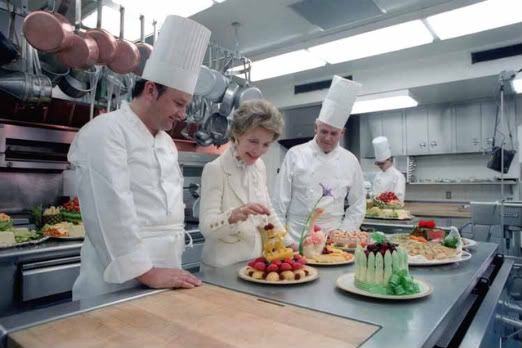
Nancy checks on dessert with Chefs Mesnier and Haller
For both State and private dinners, Nancy was involved in all aspects of planning. She was particular and exacting, requesting a new dessert for each function, approving the presentation of dishes via Polaroid photos, sometimes even stepping into the kitchen to check on a fancy platter or celebratory dessert at the last minute.
Often, she and the President pre-tested menu suggestions for approval, and for especially important gatherings, the kitchen did a dry run with scaled down portions. Everything was carefully orchestrated and perfect. Chef Haller called her a "sophisticated diner with an artist's eye for visual appeal." Her refined sense of style helped set the White House stage for the presentation of truly grande cuisine.
State Dinner with PM Nakasone of Japan (1987)
But what did the Reagans like to eat when they kicked back and dined together "above the store," or relaxed at Camp David or their California ranch?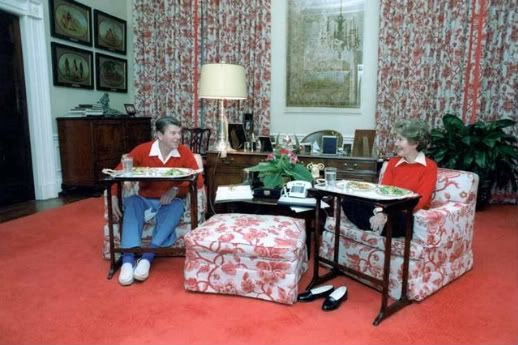
The Reagans enjoy their TV trays while watching the news (1981)
Thanksgiving with Maureen Reagan at Rancho Del Cielo (1981)
Despite the fact that as President he could request anything he desired, Ronald Reagan actually liked simple, plain, homestyle food. He hailed from the Midwest and never lost his appetite for family favorites such as macaroni and cheese, steak and chili, pizza, meat loaf and hamburger soup. He has been described as easy to please, equally enthusiastic over French cuisine that took hours to prepare as he was with a good helping of lentil soup with sliced frankfurters.
A typical breakfast for him consisted of bran cereal, skim milk, fresh fruit, and decaf coffee. Once a week, a single egg, poached, soft-boiled or scrambled, with whole wheat toast or a bran muffin. For lunch in the Oval office, he loved a bowl of soup, bread, and a fruit dessert.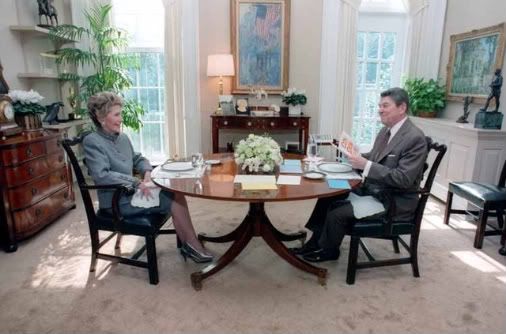
Lunch in the Oval Office on their 35th wedding anniversary (1987)
Has all this talk of homestyle food got you salivating? Here's the recipe for Ronald Reagan's Favorite Homemade Chili, which I served when my parents were visiting. I added the optional red wine (of course), and noted that it's a less tomato-y chili than what I usually make. Still, it definitely made me sit up and take notice. Hot stuff!
RONALD REAGAN'S FAVORITE HOMEMADE CHILI
(serves 16)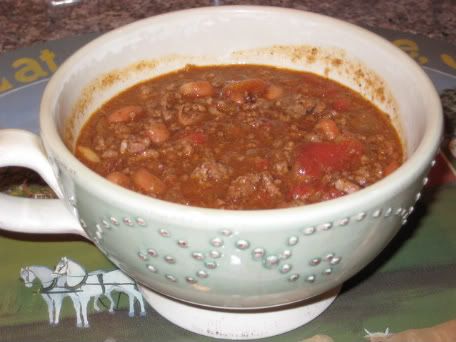
1/2 cup bacon drippings
2 cups chopped onions
4 chopped garlic cloves
2 pounds coarsely ground beef
2 T chili powder
2 cups red wine (optional)
1 T salt
1 T beef base
4 cups canned whole tomatoes, chopped
1 bay leaf
1 T granulated sugar
4 cups cooked pinto beans
Using a 1-1/2 gallon heavy pot, melt bacon drippings. When hot, saute onions and garlic cloves. Add ground beef and chili powder. Stir until meat is well browned. Add red wine. Add salt, beef base, tomatoes, bay leaf and sugar. Simmer chili meat, covered, for 20 minutes, stirring often.
Add pinto beans to the meat. Simmer for one hour, covered over low heat, stirring gently from time to time. Test for flavor.
More Reagan favorites:
Hamburger Soup (R&N brought frozen packets of this with them when they first moved into the White House)
Monkey Bread (perfect while watching "Bedtime for Bonzo")
Macaroni and Cheese (made especially for the President while he was recovering in the hospital)

Sources:
All photos courtesy of the Ronald Reagan Presidential Library.
Fabulous anecdotes and recipes can be found in Chef Henry Haller's excellent book, The White House Family Cookbook (Random House, 1987), which details his culinary experiences through five administrations -- Johnson, Nixon, Ford, Carter, and Reagan.
Details about the Reagan sweet tooth from All the President's Pastries by Chef Roland Mesnier (Flammarion, 2007).
Don't miss this treasure of a book: Politics and Pot Roast, by Sarah Hood Salomon (Bright Sky Press, 2006) -- a delightful collection of quotes, anecdotes and recipes from all our Presidents, from George Washington to George W. Bush.
"What I'd really like to do is go down in history as the President who made Americans believe in themselves again." ~ Ronald Reagan


